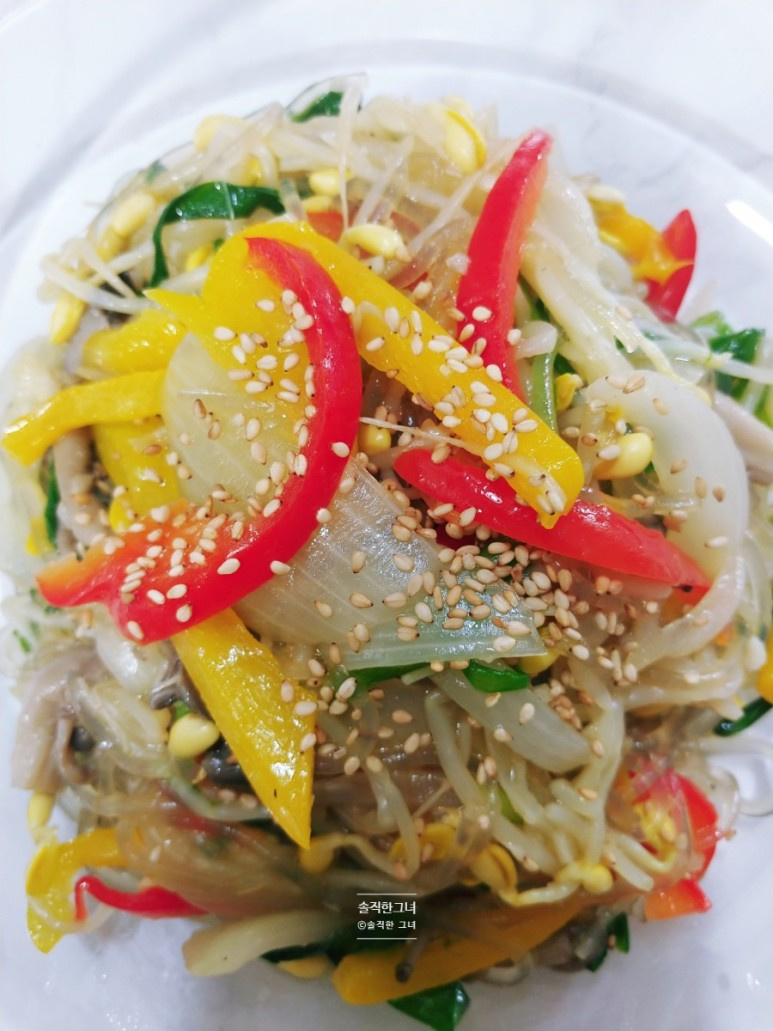Crispy Bean Sprout Japchae
How to Make Moist and Crispy Bean Sprout Japchae

We’ve made a bean sprout japchae with a wonderful moist and crispy texture. Japchae, often considered difficult to make due to its lengthy cooking process, is sometimes not fully enjoyed by family members. I wanted to create a moist japchae that everyone would love, which led to the idea of making this bean sprout japchae. Enjoy a delicious and satisfying dish!
Bean Sprout Japchae- 1 bag bean sprouts
- 150g glass noodles (dangmyeon)
- 100g oyster mushrooms
- 1 handful chives
- 1/2 onion
- 1/2 bell pepper (use various colors for visual appeal)
- 4-5 Tbsp soy sauce (adjust to taste)
- 3 Tbsp sesame oil
- 2 Tbsp minced garlic
- 1.5 Tbsp salt (adjust to taste)
Cooking Instructions
Step 1
To achieve a delightfully crispy texture, the key is properly blanching the bean sprouts! First, thoroughly wash the bean sprouts and oyster mushrooms under running water. After washing, drain them well in a colander; removing excess water is crucial.

Step 2
Next, spread the drained bean sprouts evenly on the bottom of a pot. Ensure they are spread out so they blanch evenly.

Step 3
Arrange the cleaned oyster mushrooms over the bean sprouts. Their savory flavor will meld beautifully with the sprouts.

Step 4
Pour water into the pot. Fill it only about one-third of the way. Using too much water can make the bean sprouts soggy.

Step 5
Add 1 teaspoon of salt to the water and cover the pot tightly. Let the bean sprouts blanch. Covering the pot helps retain their fresh, crisp flavor and texture.

Step 6
Once the water begins to boil, lift the lid and cook for just 1 more minute. This ensures the bean sprouts are perfectly crisp. Immediately drain the blanched bean sprouts and mushrooms in a colander. Ensuring no excess water remains is vital for a well-seasoned japchae.

Step 7
Heat a stainless steel frying pan with a generous amount of cooking oil. Add the drained bean sprouts and oyster mushrooms and stir-fry them. Thinly slice the onion and bell pepper into fine strips. Using colorful bell peppers will make your japchae visually appealing.

Step 8
While the bean sprouts and mushrooms are cooking, add the sliced onion to the pan. Stir-fry them together.

Step 9
Once the onions begin to soften and turn translucent, add the sliced bell peppers. Be careful not to overcook the bell peppers, as they can release water and become mushy. The trick is to add them after the onions are sufficiently cooked. ^^ When all the vegetables are evenly stir-fried, turn off the heat.

Step 10
Chives wilt very quickly from heat, so they are best added at the very end. The residual heat from the pan is enough to gently wilt them while keeping them wonderfully crisp. Adding them after turning off the heat is the secret to preserving their texture.

Step 11
Now, let’s season the vegetables. Add 1 tablespoon of minced garlic, about half a soju cup of sesame oil, and 1 tablespoon of salt. Adjust the seasoning according to your preference, adding more salt or soy sauce if needed.

Step 12
Using the residual heat in the pan, gently toss all the ingredients to ensure the seasoning is evenly distributed. Taste the mixture and adjust any flavors that might be lacking by adding a little more salt or soy sauce. ^^

Step 13
To shorten the cooking time for the glass noodles, soak them in cold water for at least 30 minutes before cooking. Soaking them beforehand will result in chewier and more flavorful noodles.

Step 14
While the noodles are boiling, stir them occasionally to prevent them from sticking to the bottom of the pot. Once the glass noodles are cooked to your liking, drain them and rinse them very briefly under cold water. A quick rinse while they are still slightly warm will prevent them from becoming sticky and help them retain their firm, springy texture.

Step 15
To the lightly rinsed glass noodles, add about 1.5 soju cups of soy sauce (this amount can vary depending on the total quantity of japchae), 1 tablespoon of minced garlic, and 1 tablespoon of sesame oil. Toss well until the noodles are evenly coated with the seasoning. They should take on a lovely, appetizing color.

Step 16
Finally, combine the seasoned glass noodles with the stir-fried vegetables. Gently mix everything together, using a light touch, to ensure the vegetables remain crisp. It’s important not to overmix, allowing all the flavors and textures to harmonize beautifully.




